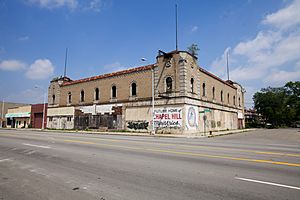Grande Ballroom facts for kids
|
The Grande
|
|

Grande Ballroom from Grand River Avenue in August, 2009.
|
|
| Location | 8952 Grand River Avenue Detroit, Michigan |
|---|---|
| Genre(s) | Jazz, Big Band, Rock |
| Capacity | 1,837 |
| Construction | |
| Opened | 1909, 1928 (dance hall); 1966 (rock venue) |
| Renovated | 1921, 1966 |
| Closed | 1972 |
| Website | |
| http://www.thegrandeballroom.com/ | |
|
Grande Ballroom
|
|
| Area | less than one acre |
| Built | 1929 |
| Architect | Charles N. Agree |
| Architectural style | Art Deco |
| NRHP reference No. | 100003226 |
| Added to NRHP | December 10, 2018 |
The Grande Ballroom is a famous old music spot in Detroit, Michigan. It's located at 8952 Grand River Avenue. The building was designed in 1928 by an architect named Charles N. Agree.
At first, it was a multi-purpose building. It had shops on the first floor. Upstairs, there was a big dance hall. This dance hall was well-known for its amazing hardwood floor.
Contents
History of the Grande Ballroom
Around 1927, a Detroit businessman named Harry Weitzman wanted to create the ballroom. He owned and paid for the building. It was a popular place for dancing and gatherings.
The Grande as a Rock Venue
In 1966, a high school teacher and radio DJ named Russ Gibb bought the Grande. He had visited the Fillmore Theater in San Francisco. Gibb wanted to create a similar place in Detroit. It would be a venue for new psychedelic music and a resource for local teenagers.
Gibb worked with John Sinclair and Hugh "JEEP" Holland. They helped bring in bands from all over. Many top local and international rock bands played there.
Famous Bands and Performances
Some famous bands that played at the Grande include Led Zeppelin, Janis Joplin, and Pink Floyd. Other big names were the Grateful Dead, Howlin' Wolf, and John Lee Hooker. Bands like Jeff Beck, Procol Harum, Cream, and The Who also performed.
The MC5, The Thyme, and The Stooges were often house bands. This meant they played there every week. The Grande also hosted jazz artists like John Coltrane and Sun Ra.
Art and Documentation
Concerts at the Grande were often advertised with cool, colorful posters. These were designed by artists like Gary Grimshaw and Carl Lundgren. A Detroit photographer, Leni Sinclair, took many pictures. Her photos showed what the rock and roll scene was like there. During this time, the Ballroom became a major center for the counterculture in Detroit.
Later Years and Recognition
Russ Gibb closed the Grande as a rock venue in 1972. Since then, the building has not been used much. It has fallen into a state of disrepair.
In 2012, a film called "LOUDER THAN LOVE-The Grande Ballroom Story" was released. This movie shared the story of the Grande Ballroom. It won an Emmy award in 2016 for its broadcast on PBS. The film features interviews with people who played or attended shows there.
In December 2018, the Grande Ballroom was added to the National Register of Historic Places. This means it is recognized as an important historical site.
What the Grande Ballroom Looks Like
The Grande Ballroom is a two-story building. It is made of yellow-buff bricks. Its design includes styles like Spanish Revival and Mediterranean Revival. The first floor used to have six retail shops. The second floor holds the large ballroom.
The outside of the building has round-arch windows on the second floor. These windows have decorative limestone carvings above them. The building's three corners facing the street have small towers. These towers have an octagonal top and a decorative design.
See also
 In Spanish: Grande Ballroom para niños
In Spanish: Grande Ballroom para niños

